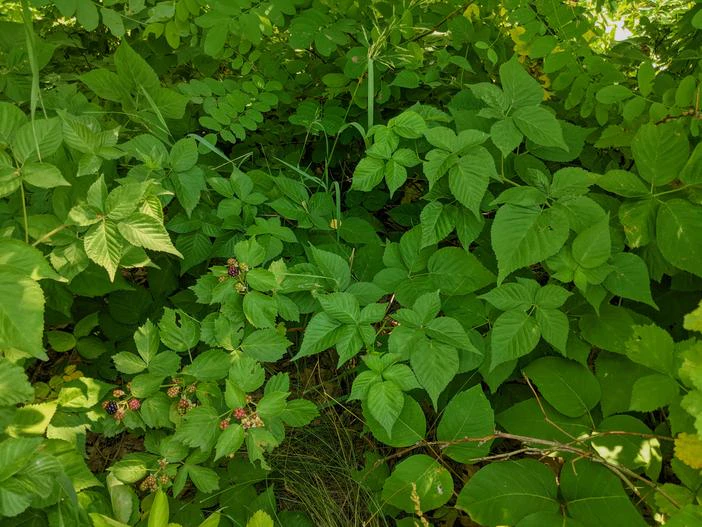Highbush Blackberry
(Rubus frondosus)
Highbush Blackberry (Rubus frondosus)
/
/

Jaxon Lane
CC BY-SA 4.0
Image By:
Jaxon Lane
Recorded By:
Copyright:
CC BY-SA 4.0
Copyright Notice:
Photo by: Jaxon Lane | License Type: CC BY-SA 4.0 | License URL: https://creativecommons.org/licenses/by-sa/4.0 | Uploader: Jaxeco | Publisher: Wikipedia Commons







Estimated Native Range
Climate Requirements
| • Precipitation | 25" - 64" |
| • High Temp. | 64°F - 94°F |
| • Low Temp. | -9°F - 52°F |
Summary
Rubus frondosus, commonly known as the highbush blackberry, is a deciduous shrub native to a variety of habitats such as forest edges, thickets, and clearings, as well as disturbed areas like fields and roadsides in Ontario and the eastern and central United States, from Maine to Georgia and west to Oklahoma, Nebraska, and Minnesota. It typically grows to a height of 3-6 feet (0.9-1.8 meters) with an equal spread, and features arching canes with clusters of white to pale pink flowers in late spring to early summer. The flowers are moderately showy and give way to edible blackberries that are attractive to wildlife and can be harvested for human consumption.
The highbush blackberry is valued for its fruit production and as a wildlife attractant. It is often used in naturalized areas, as well as in home gardens for fruit harvesting. This species prefers well-drained soils, tolerates a range of soil types, and requires full sun to part shade for optimal fruiting. While it is self-supporting, it can benefit from trellising in garden settings. Gardeners should be aware that it can become quite thorny and may spread aggressively, potentially becoming a nuisance if not managed properly.CC BY-SA 4.0
The highbush blackberry is valued for its fruit production and as a wildlife attractant. It is often used in naturalized areas, as well as in home gardens for fruit harvesting. This species prefers well-drained soils, tolerates a range of soil types, and requires full sun to part shade for optimal fruiting. While it is self-supporting, it can benefit from trellising in garden settings. Gardeners should be aware that it can become quite thorny and may spread aggressively, potentially becoming a nuisance if not managed properly.CC BY-SA 4.0
Plant Description
- Plant Type: Shrub
- Height: 3-6 feet
- Width: 3-6 feet
- Growth Rate: Rapid
- Flower Color: White
- Flowering Season: Spring, Summer
- Leaf Retention: Deciduous
Growth Requirements
- Sun: Full Sun, Part Shade
- Water: Medium
- Drainage: Medium, Fast
Common Uses
Bee Garden, Bird Garden, Edible*Disclaimer: Easyscape's listed plant edibility is for informational use. Always verify the safety and proper identification of any plant before consumption.
Natural Habitat
Native to forest edges, thickets, clearings, and disturbed areas such as fields and roadsides
Other Names
Common Names: Wild Blackberry, Bramble
Scientific Names: Rubus frondosus, Rubus brainerdii, Rubus cardianus, Rubus difformis, Rubus eriensis, Rubus heterogeneus, Rubus nescius, Rubus pauxillus, Rubus pensilvanicus subsp. frondosus
GBIF Accepted Name: Rubus frondosus